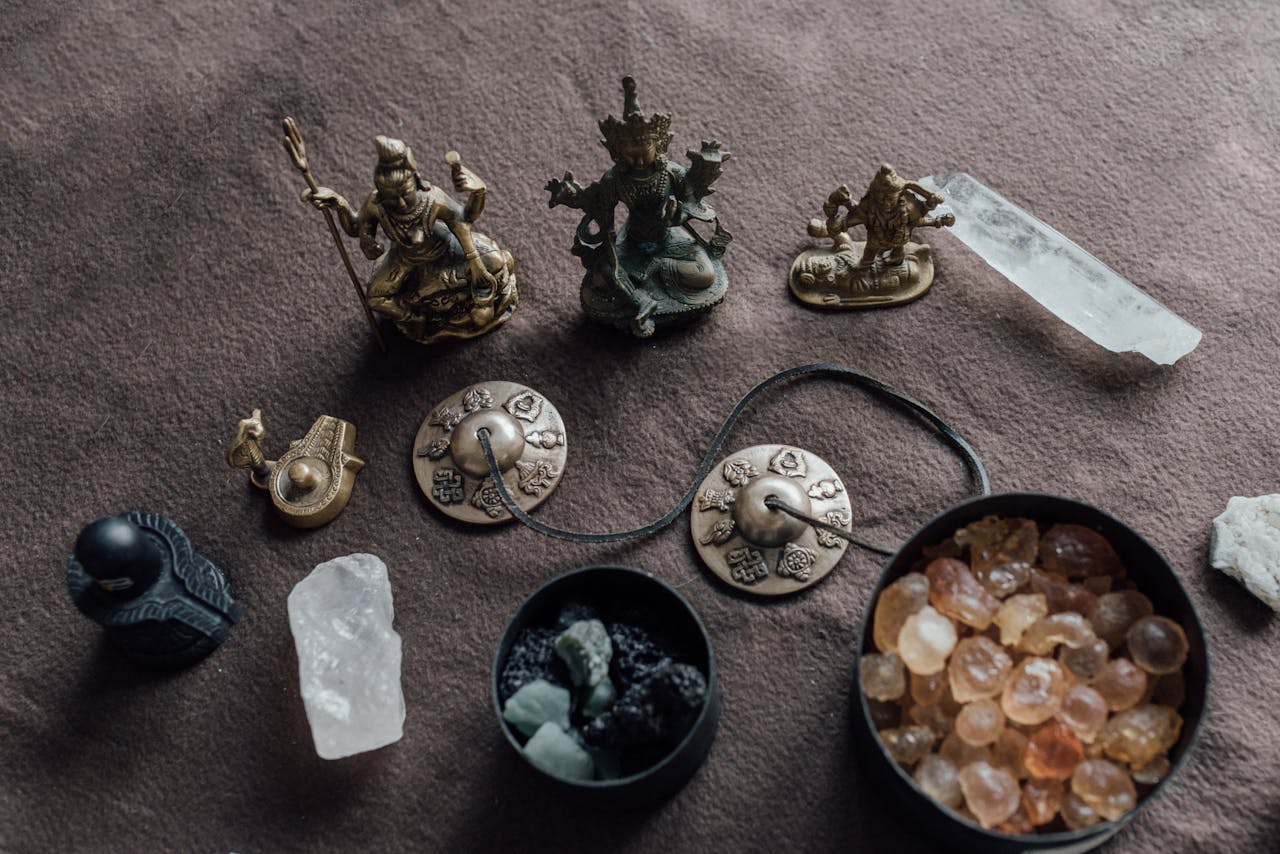
Table of Contents
A yantra is a sacred geometry symbol developed from ancient wisdom that represents the divine energy of the universe. The word “yantra” comes from the Sanskrit root “yam. ” The literal meaning is “to control, bind, curb, or influence.”
What is a Yantra?
A yantra is a form, simple or complex, towards a particular purpose, providing human beings with a source of supreme knowledge.
Yantras are tools for meditation, mantra recitation, and prayer, helping to focus on intentions harmoniously and channel the universe's energy into the body.
People can create yantras using various materials, including metal such as copper plate, wood, glass, cloth, and paper. They can be simple geometric forms or patterns with thousands of interlocking parts.
The Origins of Yantras
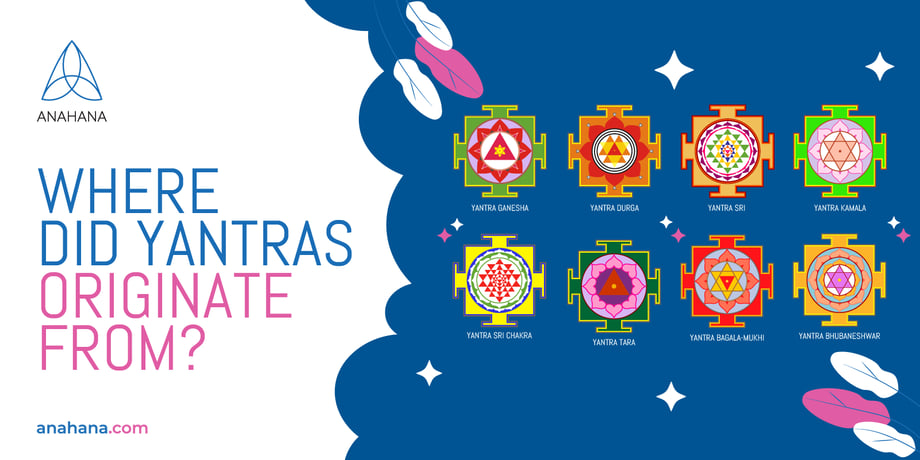 Yantras trace back to the Vedic period in India (c. 1500-500 BCE), originating in India over 5,000 years ago. The Vedas, the sacred texts of Hinduism, were the first book to mention them. Yantras were initially used as a tool for ritual worship and later became associated with a mystical diagram and magical spell.
Yantras trace back to the Vedic period in India (c. 1500-500 BCE), originating in India over 5,000 years ago. The Vedas, the sacred texts of Hinduism, were the first book to mention them. Yantras were initially used as a tool for ritual worship and later became associated with a mystical diagram and magical spell.
The use of yantras spread throughout Asia and eventually to the West. In the 20th century, they became popular among new-age spiritual seekers and hippies. Today, people of all faiths and backgrounds use yantras to connect with the divine energy of the universe.
The term yantra means "machine" or "instrument" in Sanskrit. It can also mean "support" or "aid," corresponding to their use as tools to help us achieve our spiritual and material goals.
Historical and Cultural Significance of Yantras
After understanding the origins of yantras, it's pivotal to explore their historical and cultural significance. This journey unveils how yantras have transcended their initial spiritual purpose, influencing various aspects of life across different cultures and epochs.
Ancient Practices and Rituals: Yantras, rooted in ancient wisdom, were integral to rituals in Vedic India. They were not merely symbols but tools for connecting with higher consciousness. Their use extended into Buddhist meditation practices, used by Buddhist monks, where they aided in focusing the mind and achieving spiritual awakening.
Symbolism in Different Cultures: While originating in India, yantras found resonance in diverse cultures across Asia. In each culture, these sacred geometries took on unique interpretations, reflecting local spiritual beliefs and practices. Their arrival in Western cultures in the 20th century marked a new era of spiritual exploration, where yantras were embraced by various new-age movements.
Evolution Over Centuries: The evolution of yantras is a tale of spiritual ingenuity. Over centuries, from the Vedic period to medieval India, and into the modern era, the designs and purposes of yantras have morphed. Initially central to religious rituals, they gradually became symbols of meditation and self-realization, adapting to the changing spiritual landscapes.
Influence on Architecture and Art: Yantras have left a lasting impact on architecture, most notably in Southern India. Here, temples are often constructed in the shape of yantras, embodying spiritual concepts in their very design. The influence of yantras extends into various art forms, where their intricate designs inspire patterns and motifs.
Modern Adaptations and Uses: In contemporary times, yantras have transcended traditional bounds. They are now seen in modern art, therapy sessions, and even in interior design, serving as symbols of peace and harmony. Their geometric patterns and symbolic meanings appeal to a broad audience, providing both aesthetic value and spiritual depth.
Integration with Other Spiritual Practices: The versatility of yantras is evident in their integration with other spiritual practices such as yoga and tantra. In these practices, yantras serve as focal points for meditation, aiding in the alignment of divine energies and the pursuit of spiritual goals.
Yantras are not just ancient spiritual symbols; they are dynamic, evolving elements that continue to influence spiritual practices, art, and culture. Their journey from Vedic tools to modern symbols of tranquility highlights their enduring relevance and adaptability.
Yantra Structure
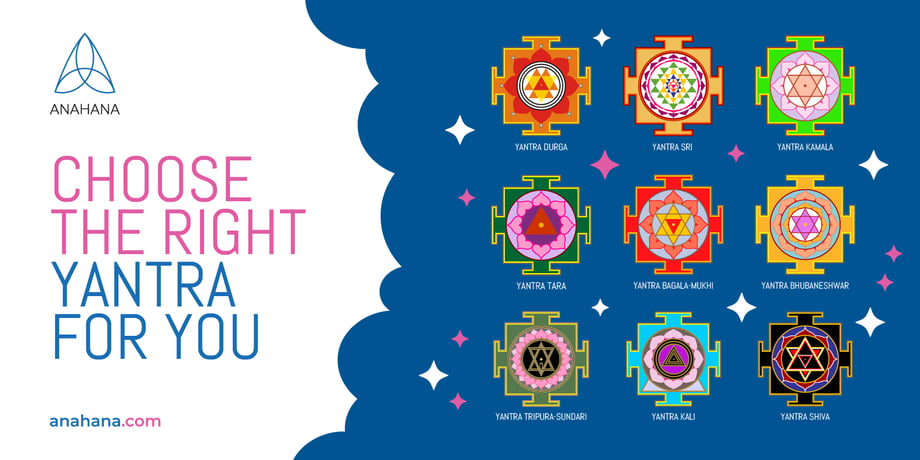 Yantras are geometrical patterns made of several figures like squares, circulars, triangles, lotuses, and points. They typically have three parts: the Bindu, the Shringara, and the Chakra.
Yantras are geometrical patterns made of several figures like squares, circulars, triangles, lotuses, and points. They typically have three parts: the Bindu, the Shringara, and the Chakra.
Bindu - Traditional yantras have the Bindu as the central point of the yantra. It is said to be the symbolic representation of the original form, known as ellipsoid or linga. The Bindu is a dot, circle, or point in the center of the yantra. The starting point of the Bindu to the outer square represents universal evolution.
Triangle - Yantras often include either a downward-pointing triangle (feminine) or upward-pointing triangle (masculine).
Hexagram - Hexagrams are two triangles intertwined, representing the union of masculinity and femininity.
Lotus - Lotus petals contribute to yantras, representing purity and transcendence.
Circle - Yantras will often representation by including three circles in the center.
Outer Square - Yantras sometimes include inner or outer squares, representing the four directions of the earth.
Pentagram - Pentagrams are often incorporated into yantras, with the number five’s association with Kali.
Octagon - Yantras sometimes have octagons to represent the eight different directions.
The Shringara is the creative energy that flows out from the Bindu. Lines or petals represent the Shringara, radiating from the central point.
The chakra is the outermost part of the yantra, depicted as concentric circles, squares, and floral patterns. The chakra represents the different aspects of reality, such as the five elements or the seven chakras.
How to Use a Yantra
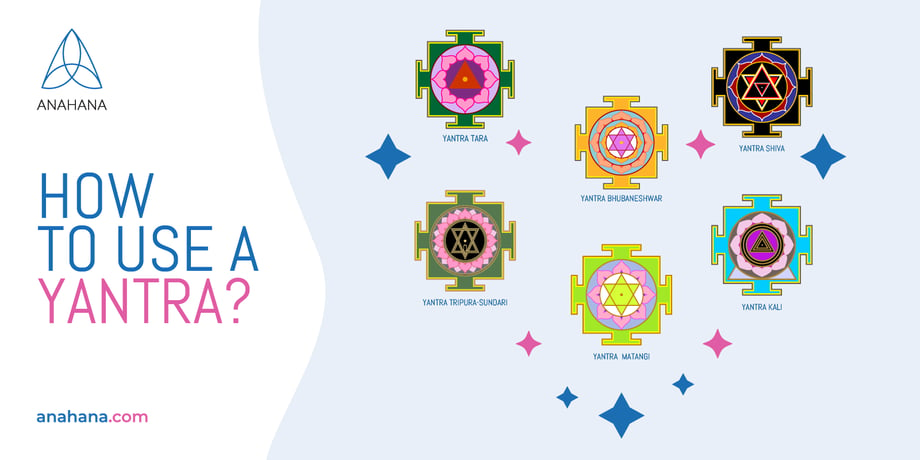 There is no single correct way to use a yantra. Some people meditate on them, while others simply keep them in their homes or workplaces as a reminder of the divine presence in the universe.
There is no single correct way to use a yantra. Some people meditate on them, while others simply keep them in their homes or workplaces as a reminder of the divine presence in the universe.
Here are a few tips on how to get started with using yantras:
-
Find a comfortable place to sit or stand. You can also lie down if you prefer.
-
Hold the yantra in your hands, or place it before you.
-
Close your eyes and take a few deep breaths.
-
Gaze at the yantra and allow your mind to focus on its shape and form.
-
Repeat a mantra, such as “Om Namah Shivaya,” or simply recite the names of the deity associated with the yantra. Mantras, which are Sanskrit syllables inscribed on yantras, are essential "thought forms" that represent divinities or cosmic powers and exert their influence through sound vibrations.
-
Continue for as long as you like. You can also use a timer if you prefer.
-
When you’re finished, take a few deep breaths and open your eyes.
Incense sticks, mantras, essential oils, crystals and stones, and other supportive materials can enhance the meditative experience.
What are the Benefits of Using a Yantra?
There are many potential benefits of using a yantra for one’s life. Yantra helps attract , abundance, prosperity, well-being, and good luck. Here are a few of the most commonly cited ones:
- Yantras can help focus the mind and still the thoughts.
- Yantras can help channel the energy of the universe into the body.
- Yantras can are tools for meditation, mantra recitation, and prayer.
- Yantras can help connect with the divine power of the universe.
- Yantras promote health, wealth, and prosperity.
- Yantras can help protect against negative energies and influences.
- Yantras can attract love, round success, and abundance.
How to Make a Yantra
Here are a few tips on how to make a yantra:
- Start with a simple design.
- While yantras are three-dimensional, the representation is drawn in two dimensions. One can use a ruler or other straight edge to help create clean lines. Using a pen or pencil, use light pressure to erase any mistakes easily.
- Experiment with different materials and mediums. One can even create digital yantras using software like Adobe Illustrator.
- Yantras can be as simple or complex as one would like. The most important thing is that they hold personal meaning for the practitioner.
Types of Yantras
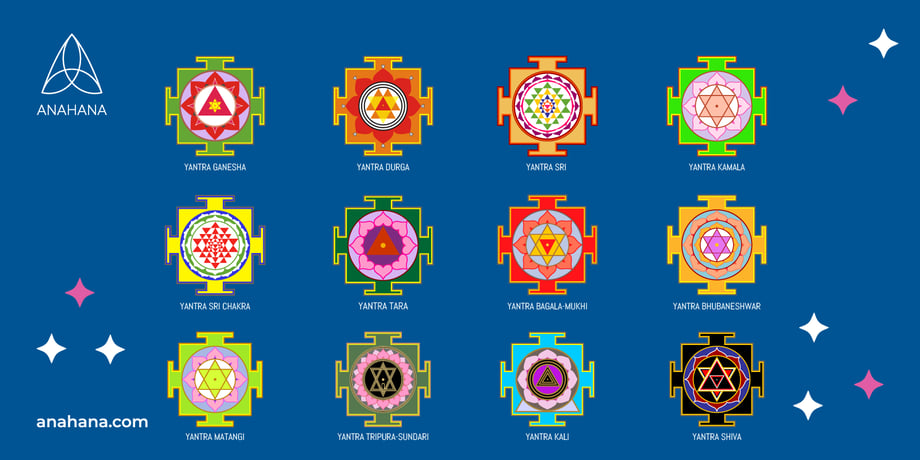 Many different types of yantras invoke cosmic unity. Specific yantras are associated with different things. Some designs have particular purposes, such as attracting wealth or improving health.
Many different types of yantras invoke cosmic unity. Specific yantras are associated with different things. Some designs have particular purposes, such as attracting wealth or improving health.
Others are more general and can apply to a variety of purposes.
Here are some of the most popular types of yantras:
- Sri yantra: This is one of the most popular and well-known yantras, outlined in its three-dimensional projection known as Sri Meru or Maha Meru. Also called the Shri yantra and Sri Chakra, it represents the divine feminine energy. It has various purposes, such as increasing wealth, improving relationships, or attaining enlightenment.
- Ganesh yantra: This yantra honors the Hindu deity Ganesh. It is said to help remove obstacles and achieve success in all endeavors.
- Avighna yantra: This powerful yantra removes all obstacles from one’s life. It applies to everything from improving health to attracting wealth and success.
- Saraswati yantra: This yantra honors the Hindu goddess Saraswati. It helps acquire knowledge, wisdom, and creative inspiration.
- Lakshmi yantra: This yantra honors the Hindu goddess Lakshmi. It helps attract wealth, prosperity, and abundance.
- Durga yantra: This yantra honors the Hindu goddess Durga. It helps people overcome obstacles, achieve success, and attain victory. Further, it wards off the evil influences of planets, the evil eye, and spirits.
- Kali yantra: This yantra honors the Hindu goddess Kali. It is said to help destroy negative energies and succeed in all endeavors.
- Maha Mrityunjaya yantra: This yantra works by conquering death and achieving immortality.
- Linga Bhairavi yantra: This sacred geometry image represents the union of Masculine and Feminine energies. It helps increase wealth, improves relationships, and attains enlightenment.
- Trikona yantra: The Trikona Yantra is the symbol of Shakti, the feminine energy or aspect of creation. It is a powerful tool for manifesting desires. It attracts things people want, such as wealth, success, love, or anything else.
No matter what type of yantra one chooses to use, remember that the key is to approach the practice with an open mind.
How to Choose a Yantra
 When choosing a yantra, finding one that resonates with the practitioner is essential. Many different yantras are available, so people should take their time and explore until to find one that feels right.
When choosing a yantra, finding one that resonates with the practitioner is essential. Many different yantras are available, so people should take their time and explore until to find one that feels right.
In addition to finding a yantra that resonates, choosing one that is appropriate for the practitioner's purpose is also essential. When looking to improve one’s health, for example, people might choose a different yantra than if they were looking to attract wealth and abundance.
When in doubt, it is always best to ask a teacher or guru who can help guide the right yantra for the individual’s needs.
Frequently Asked Questions
Do I need to be Hindu to use a yantra?
No, one does not need to be Hindu to use a yantra. People of any religion or belief system can use yantras.
Can I make my yantra?
Yes, people can make their yantra. Refer to the article's section on how to make a yantra to learn how.
Do I need to consecrate a yantra before using it?
No, people do not need to consecrate a yantra before using it. However, some people believe that doing so can increase the effectiveness of the yantra.
How long does it take to see results from using a yantra?
This depends on many factors, such as their intention, focus, and dedication. Some people see results immediately, while others may need to use the yantra for longer before seeing results.
Do yantras benefit people?
It certainly does. Yantras have been used since 3300 B.C., as evidenced by their discovery during the excavation of the Harappa civilization.
Assuring the benefits of Yantra has resulted in the construction of temples in the shape of Yantra, which is most common in Southern India.
When focusing on yantra, one’s mental narratives stop, which helps to stabilize the mind and opens the door to divine energies.
Which Yantra is more powerful?
The power of a yantra is subjective and varies according to individual belief and purpose. However, the Sri Yantra is often considered one of the most powerful yantras. It represents the divine feminine energy and is said to contain all forms of yantras within it. It's used for a variety of purposes, including spiritual enlightenment, material abundance, and the fulfillment of desires.
What does the Yantra symbolize?
A yantra symbolizes the universe's divine energy and its various aspects. Each part of a yantra, from its geometric shapes to its center point (Bindu), represents different spiritual concepts - such as creation, the union of masculine and feminine energies, and spiritual awakening. It's a visual manifestation of higher spiritual truths.
What is a Buddhist Yantra?
A Buddhist Yantra is a visual representation used in Tibetan and other forms of Buddhist meditation. These yantras are similar to mandalas and often include specific geometric shapes and symbols that represent various aspects of Buddhist philosophy and cosmology. They are tools for meditation, helping to focus the mind and facilitate deeper spiritual insight.
Does Yantra really work?
The effectiveness of a yantra depends on one's beliefs, intentions, and the manner of use. Many practitioners believe that yantras can have a significant impact when used with dedication and proper understanding. The belief is that a yantra, when meditated upon, can bring about spiritual growth, mental clarity, and manifestation of specific goals.
References
Types, Meaning, Benefits and list of Powerful Yantra with Uses - Rudra Centre
What are Yantras? How does it help? - Times of India
What is Yantra? - Definition from Yogapedia
Disclaimer
The contents of this article are provided for informational purposes only and are not intended to substitute for professional medical advice, diagnosis, or treatment. It is always recommended to consult with a qualified healthcare provider before making any health-related changes or if you have any questions or concerns about your health. Anahana is not liable for any errors, omissions, or consequences that may occur from using the information provided.

By: Anahana
The Anahana team of researchers, writers, topic experts, and computer scientists come together worldwide to create educational and practical wellbeing articles, courses, and technology. Experienced professionals in mental and physical health, meditation, yoga, pilates, and many other fields collaborate to make complex topics easy to understand. Anahana is also home to specialists in crystals, tarot, angel numbers, astrology, life path numbers, zodiac signs, and horoscopes. By combining evidence-based wellness with spiritual and energetic practices, the team offers clear, trustworthy guidance for both mind-body health and modern spirituality.